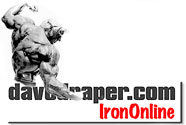Grip Work
From the IronOnline Archive
John's Grip Work
Two years ago, I couldn't deadlift 225 (an Oly bar and 4-45lb plates, 2 each side) for a work set of 5 reps without my grip giving me a problem. And I practice the method of deadlifting form where every rep is like a single, stopping and resetting between each rep. (This gives the old grip a little break in between reps.) I wanted to deadlift so bad, I started asking around, looking and then incorporating grip work into my routine. I now have the personal standard that if I can't hold on to it, I don't lift it! My grip is now stronger than my body's ability to perform.
A physiotherapist who was also a bone-doctor once told me that with straps, I could potentially injure every and/or any joint in my hands and arms including my shoulder joints. He said as long as my forearms are flexed, gripping onto the bar tightly, all the muscles and connective tissues are supporting those joints. But, with the straps in place, it's possible to relax my grip a little and that's when the injury can occur - my muscles stop protecting the joints and something gives.
So, if you're going to use straps, keep gripping as tight as you can for your joints sake. Here's some of the exercises I used in the last two years to improve my grip. I always do grip work after any exercises needing the hands is completed.
1. Regular wrist curls done two ways. One day I'll do them with very limited movement, just breaking the wrist and curling them up to level position but not the hypercontracted "burn" position. I use a lot of weight for these and keep the reps low, no more than 5. I only do two sets of 3-5 this day. The second way I do wrist curls is to lighten up the weight and do the kind where you open your hands on the way down so that the bar is being cradled in the curl your finger tips, then slowly with concentration rolling the bar up to the level position. After completing 5 or 6 reps of these I do as many hypercontractions from level to hyper position as I can until my grip gives up.
2. Reverse curls for the top of the forearm. It is important to balance your wrist curling muscles with your wrist extension muscles. If you don't, you will strain your elbow from the imbalance of these two antagonist forearm muscles. I do them slow up and slow down being careful to "think" the exercise into the forearm, not the bicep. I also pay attention to how my elbows are feeling --> any sensation of strain at all and the set is over. You can set up a more severe injury later in a compound exercise by going too far in this isolation one.
3. Hanging from an overhead chinning bar for an extended period of time, with weights if necessary. This one is only to be done after you've toned up your forearms with #1 and #2 above. That's because it's going to pull very hard on the ligaments near the outside of your elbow. Hold on tight as long as you can in suspended position with your strongest grip position. I use a very wide, pronated grip for each hand. Once you can hold on with bodyweight for a minute, add weight with a harness or chain. Go slow on this one though so you don't get hurt. Pay attention to your ligaments and stop when you feeling anything going on there. Muscle ache is okay. Just ignore that until your grip gives out :)
4. Farmer's carry. Pick up a couple of heavy dumbells and carry them around the perimeter of the gym and then re-rack them or put them down on the floor before racking. Work your way up each workout until you're using the largest dumbells available. If once around the gym doesn't tax your grip, try twice around, or until you are "grip challenged". This is also an advanced grip exercise, so don't get too enthiastic with the weight on this one until you've built up some history with it and exercises #1 and #2.
5.Static contraction deadlifts in a power rack. For this one you set up the power rack so you only have to lift the bar 6-8 inches below your standing deadlift position, weight supported my your body and grip. Since it's deadlifts you want to improve your grip for, this is a natural because after you've worked your way up in this exercise, you'll find yourself stronger in the lower back for your regular deadlifts. It will also strengthen all the tendons and ligaments in your arms and shoulders. This one's easy. First time out, just put 10% more on the bar than you're used to doing for a work set of deadlifts. Prepare yourself for the lift by slowly contracting all the muscles you use in your deadlift and finally squeeze the bar off the holding pins. Using a kitchen timer, a stop watch or a partner, have the number of seconds you can hang on timed. Once you reach thirty seconds in a workout, make a note to increase the weight another 10% next time. You only do ONE repetition of this exercise. Yup, just one. And do this at the end of your exercises that use your grip. (You'll also be warmed up then too.) Of all the exercises listed, I believe this one is certainly the most productive in improving your grip for deadlifts because it uses the deadlift position and muscles as the training stimulus.
With this routine and two years, I can now hold on to the bar and do partial deadlifts with 600 pounds and get three to five reps in a row or a static contraction of 15-20 contiguous seconds. This gives me plenty of grip for my work set of full deadlifts with 400.
Wow! I really went on there. Hope this helps anybody trying to get a grip on things! :)
Pumping up, pumping iron!
John
Return to the IOL Sample Workouts
Click here for Dave's arm priority training
Here's our IOL arm training archive
This bit's about Dave's forearm routine
Can we answer any of your training questions in the forum?
This is a list of Dave's columns

